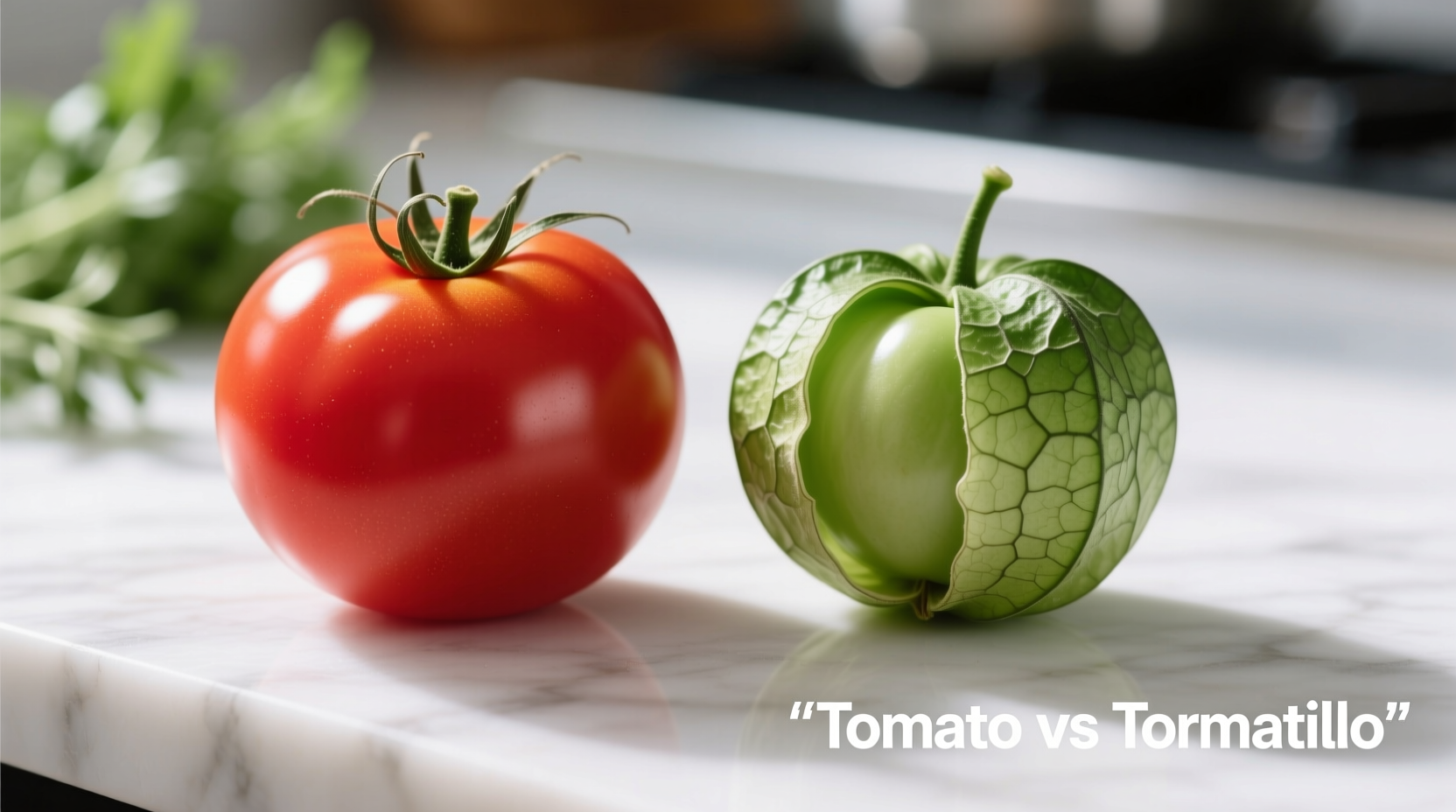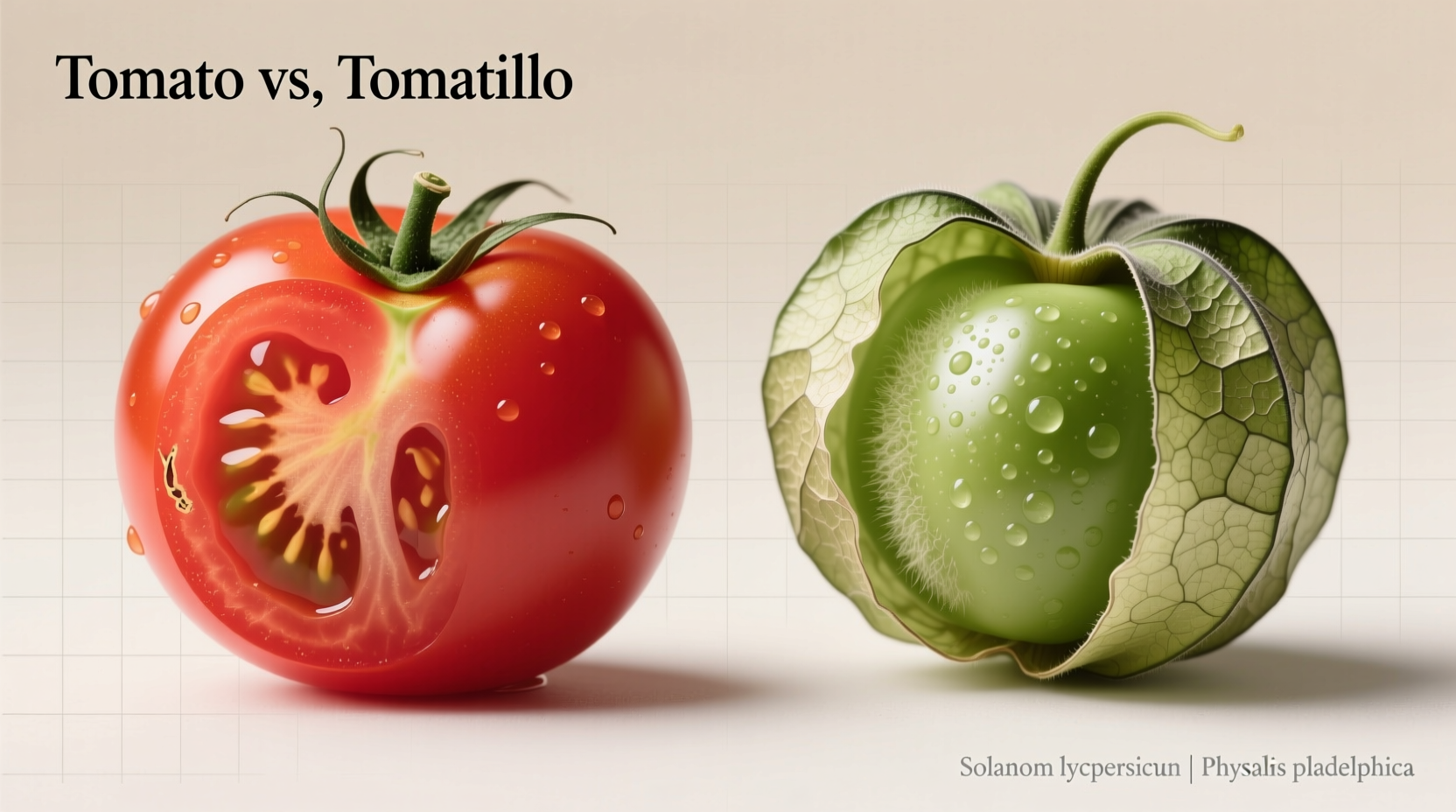Tomatoes and tomatillos are botanically related but distinct ingredients with unique flavors, textures, and culinary applications. Tomatoes (Solanum lycopersicum) are sweet, juicy fruits with smooth skin, while tomatillos (Physalis philadelphica) are tart, firm vegetables encased in papery husks. Understanding these differences ensures proper usage in recipes, particularly in Mexican and Central American cuisines where tomatillos are essential.
Ever reached for a tomato only to find a strange green fruit wrapped in a papery husk? You've encountered the classic tomato vs tomatillo confusion. As a Latin American cuisine specialist who's studied indigenous ingredients across Mexico and Central America, I've seen how this mix-up ruins otherwise perfect salsas and stews. This guide cuts through the confusion with precise identification tips, flavor comparisons, and culinary applications you can trust.
Visual Identification: Spotting the Difference at a Glance
Before they even reach your kitchen, tomatoes and tomatillos look nothing alike. Tomatoes grow exposed on the vine with smooth, thin skin ranging from red to yellow, purple, or even black depending on the variety. Tomatillos, however, develop inside a distinctive lantern-like husk that turns from green to tan as they mature. This husk isn't just decorative—it protects the fruit and indicates freshness. When shopping, choose tomatillos with tight-fitting husks that feel firm and fill the entire husk.
| Feature | Tomato | Tomatillo |
|---|---|---|
| Outer covering | Smooth skin | Papery husk (calyx) |
| Color when ripe | Red, yellow, orange, purple | Green, purple, or yellow |
| Texture | Soft, juicy | Firm, dense |
| Shape | Round, oval, or irregular | Round, typically 1-2 inches |
| Stem attachment | Dry scar | Attached within husk |
Flavor Profiles: Why Substitution Changes Everything
Tomatoes deliver that familiar sweet-acid balance we love in everything from salads to sauces. Their flavor ranges from sugary sweet (like heirloom varieties) to bright and tangy (cherry tomatoes). Tomatillos, however, offer a completely different experience—a bright, citrusy tartness with herbal notes that intensifies when cooked. This distinctive flavor forms the backbone of authentic green salsas and moles. Unlike tomatoes that soften dramatically when cooked, tomatillos maintain their structure while mellowing in acidity.

Culinary Applications: When to Choose Each Ingredient
Understanding context boundaries prevents recipe disasters. Tomatoes shine in Mediterranean dishes, fresh salads, and cooked sauces where their sweetness balances acidity. Tomatillos are non-negotiable in traditional Mexican cuisine—they're essential for authentic salsa verde, pozole verde, and chilaquiles verdes. While some recipes suggest substituting green tomatoes for tomatillos, this creates a fundamentally different dish. Green tomatoes lack the complex herbal notes and maintain excessive tartness even when cooked.
Professional chefs in Oaxacan kitchens taught me a crucial distinction: tomatoes work best when their flavor should dominate (like in a caprese salad), while tomatillos function as supporting players that enhance other ingredients (as in complex moles where their tartness cuts through rich meats).
Nutritional Comparison: Beyond Flavor Differences
Both ingredients offer impressive nutritional profiles but with key distinctions. Tomatoes lead in lycopene—a powerful antioxidant responsible for their red color that's linked to heart health. Tomatillos contain higher levels of dietary fiber and vitamin C. According to USDA FoodData Central, a 100g serving of tomatillos provides 13.9mg of vitamin C (15% of daily value) compared to tomatoes' 13.7mg, but tomatillos deliver nearly double the fiber content at 2.3g versus tomatoes' 1.2g.
Historical Context: Evolution of Two American Staples
Both plants originated in the Americas but followed different culinary paths. Tomatoes were first cultivated by the Aztecs around 500 CE but weren't widely adopted in Europe until the 16th century due to initial fears they were poisonous. Tomatillos have an even longer history—they've been found in pre-Columbian archaeological sites dating back to 800 BCE. Unlike tomatoes that spread globally, tomatillos remained primarily within Mesoamerican cuisine until recent decades. This explains why many non-Latin American cooks remain unfamiliar with them despite their culinary significance.
Storage and Preparation Tips
Store tomatillos in their husks in a paper bag in the refrigerator for up to two weeks—they'll continue ripening slightly. Remove husks only before use and rinse off the sticky residue. Tomatoes should never be refrigerated unless cut, as cold temperatures destroy their flavor compounds. For cooking applications requiring roasted flavor, tomatillos develop deeper complexity when roasted or boiled whole in their husks before husking.
Common Misconceptions Clarified
"Tomatillos are just unripe tomatoes"—this is completely false. They're different species with distinct genetic profiles. "You can substitute green tomatoes for tomatillos"—while sometimes suggested, this creates a fundamentally different flavor profile. "Tomatillos are always green"—they actually ripen to purple and yellow varieties with sweeter profiles ideal for different applications.
When Substitution Makes Sense (and When It Doesn't)
Never substitute in traditional Mexican recipes where tomatillos are essential. However, for non-traditional applications requiring tartness, consider these guidelines: use underripe tomatoes only when tomatillos are unavailable and the recipe specifically calls for tart green fruit. For authentic Mexican dishes, no substitution preserves the intended flavor profile. If you must substitute, add a squeeze of lime to green tomatoes to approximate tomatillo's citrus notes.











 浙公网安备
33010002000092号
浙公网安备
33010002000092号 浙B2-20120091-4
浙B2-20120091-4